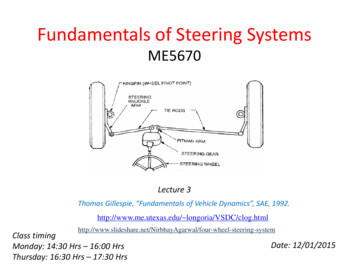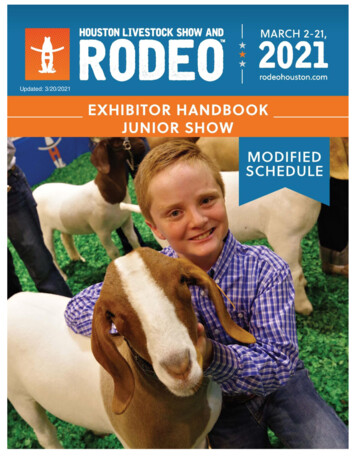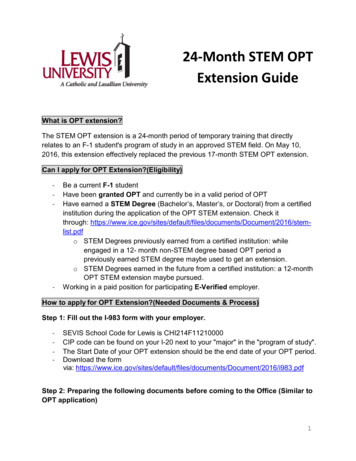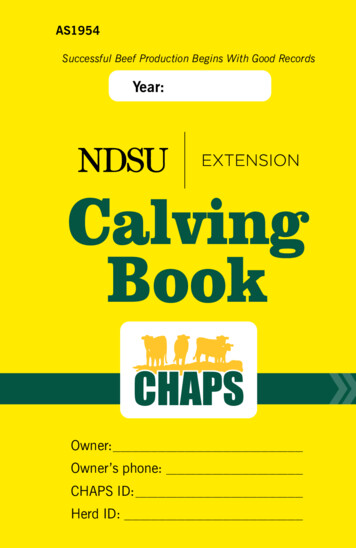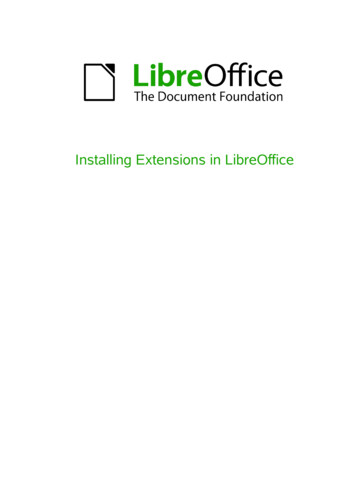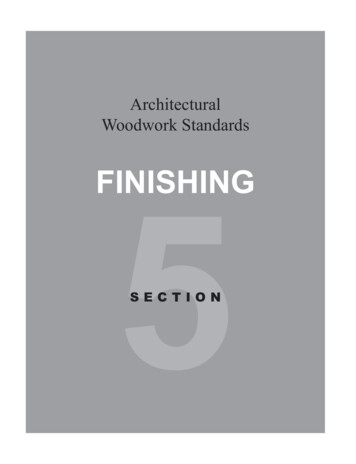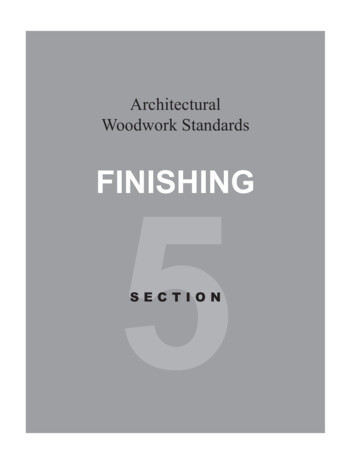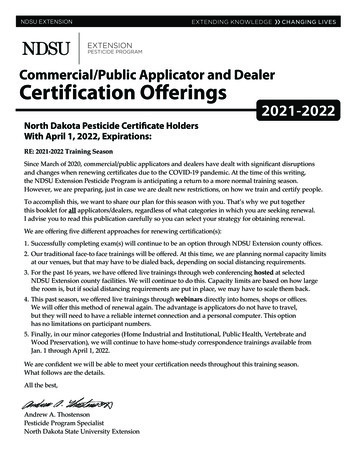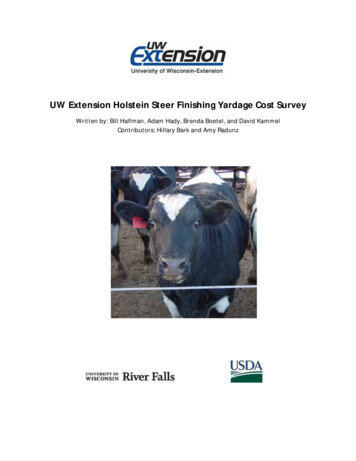
Transcription
UW Extension Holstein Steer Finishing Yardage Cost SurveyWritten by: Bill Halfman, Adam Hady, Brenda Boetel, and David KammelContributors: Hillary Bark and Amy Radunz
Bill Halfman, UW-Extension Agriculture Agent, Monroe CountyAdam Hady, UW-Extension Agriculture Agent, Richland CountyBrenda Boetel, UW-Extension Livestock and Grain Marketing Specialist and UW-River Falls Departmentof Ag Economics, River FallsDavid Kammel, UW Biological Systems Engineering Extension Specialist, MadisonContributors: Hillary Bark, former UW Madison Animal Science Summer Intern, and Amy Radunz, UWRiver Falls Animal and Food Science, River FallsReviewer: Gary Hachfeld, Farm Business Management Educator, University of Minnesota Extension 2015 by Board of Regents of the University of Wisconsin System doing business as the Division of Cooperative Extension ofthe University of Wisconsin-ExtensionAn EEO/Affirmative Action employer, the University of Wisconsin Extension provides equal opportunities in employment andprogramming including Title IX and ADA requirements.
UW Extension Holstein Steer Finishing Yardage Cost SurveyThe objective of this survey was to gather information on yardage costs of production for Wisconsindairy steer feedlot enterprises. Information was obtained from feedlot operations feeding at least 50%dairy steers. The data collected was producer’s annual costs for finishing dairy steers from at least 300pounds or reported higher placement weights though finishing. This data was then used to calculatecosts on a daily basis.This Holstein steer yardage survey focused on overhead, labor/management, bedding, and directexpenses generally associated with yardage costs. It did not include feed, animal, and veterinarian/pharmaceutical related costs. This project was conducted by UW Extension and UW-River Falls and waspartially funded with USDA Risk Management Agency grant funds.Data was gathered by UW Extension Agriculture Agents from cooperating producers in 2012. Therewere 17 farm operations that had complete enough information to be included in the analysis.MethodsField data was collected by seven UW Extension Agriculture Agents and one summer intern using ageneral survey questionnaire to gather labor and bedding costs and use, and a spreadsheet that wasadapted from the UW Extension Yardage Calculator (Hadley, Boetel and Halfman) to gather overheaddata (cattle inventory, machinery, housing and facilities, feed storage, manure storage, etc.).Labor and management data collected included paid and unpaid hours. Unpaid labor and managementhours were hours of labor and management reported by the participants that they indicated as not paida wage. Most of the unpaid labor and management were completed by the owner or their family, butwe do not know that for sure. Wage rates were also collected from all cooperators who reported paidlabor and management. For all unpaid hours of labor a wage rate of 10 per hour was assigned. A wagerate of 15 per hour was used for all unpaid management reported. A worksheet was prepared byHalfman that broke out tasks into daily, weekly, monthly, or less frequent tasks to help identify all thelabor and management of the steer finishing operation.Bedding data collected included type of bedding material(s) used, tonnage and cost. If farmers did notprovide a cost/value due to using homegrown bedding, a standardized opportunity cost of 30 per tonfor soybean stubble, 60 per ton for corn stalks and 90 per ton for straw was used.Machinery data collected was for machinery and equipment used directly in the cattle feedingenterprise, not for growing and harvesting feed. Farmers provided a percentage of time used in thecattle feeding enterprise for machinery and equipment that was used on several enterprises on thefarm. Farmers were asked to provide model, size, age, estimated current market value, and years theyintended to keep each piece of machinery. An ending/salvage value for the machinery and equipment,to determine straight-line depreciation, was determined using the “percentage of new list price“procedure outlined in the Iowa Ag Decision Maker Fact Sheet A3-29 Estimating Farm Machinery Costs(Appendix Table 1). New list prices for machinery and equipment were obtained from implementdealers in western Wisconsin. A five percent increase was added to annual depreciation to account forthe cost of machine storage if the equipment was stored inside. Area implement dealers and HotlineFarm Equipment Guide were used to determine current market prices of items that the farmers werenot sure of or did not provide current market values for.1
Because of large variations in the age, design, and condition of buildings and facilities on surveyedoperations, no single method of determining fixed costs for those items adequately fits all situations. Inan effort to standardize determination of fixed costs for facilities across operations, a replacement valuefor feedlot, housing, feed bunks, cattle handling, and manure storage facilities was assigned usingreplacement values that were provided by Dr. David Kammel, UW Extension Agriculture and BioSystems Engineer (Appendix Table 2). Grain bin values were obtained from Steel Grain Bins from theMichigan Department of Treasury (Appendix Table 3). All facilities were assumed to have a 20 yearuseful life and straight line depreciation was applied using the replacement cost. The justification forthis procedure is that for an operation to be sustainable, it must generate enough revenue to be able toreplace items when they are worn out, or pay for them over their useful life. If an item no longer has adebt assigned to it, but still has a useful life a cost should be charged to it that can be applied toreplacing it, once that time is determined by the owner.A list of related expenses typically considered part of yardage costs was collected from cooperatingfarms. These included, but are not limited to taxes, insurance, utilities, fuel, repairs, custom hire,interest, permits, and marketing. The cooperators were asked to report the total for the entireoperation and estimate what percent of each was incurred by the cattle finishing operation.Cattle days on feed were determined by the cooperating farms describing how many head they had onhand and how many days they would be on site. Most operations reported that they typically had aconsistent number of head at the farm all year. We used the reported daily average number of cattle ininventory multiplied by 365 days to determine cattle days for farms reporting always having cattle ininventory. For farms that reported having cattle in inventory less than all year long we used the numberof days reported.Overhead costs were calculated for each operation using the data collected as described above and thedata was pooled to calculate ranges and averages.2
ResultsThere were seventeen cooperating farms with adequate data to calculate yardage costs. Theseoperations ranged in size from 34 head on feed to 1000 head on feed. The average number of head onfeed was 178 and the median was 127 head on feed. This wide range is typical of the variability offeedlot enterprise size that we see in Wisconsin.The average yardage cost including paid and unpaid labor/management and bedding for cooperatingfarms was 0.96 per head per day. The median was 0.85 per head per day. The range was 0.47 perhead per day to 1.45 per head per day. Table 1 is an itemized list with the ranges of costs for thedifferent areas used to calculate yardage.Table 1. Breakdown of Yardage Components (all costs in dollars per head per day)CostTaxesInsuranceDues and FeesIntermediate and long term interestFuel and OilUtilitiesPaid LaborPaid ManagementUnpaid LaborUnpaid ManagementMachinery RepairsFacility RepairsHired Cattle HaulingMiscellaneousAdvertisingMachinery depreciation and leaseBuilding /Facility depreciation & leaseBeddingPermits and CertificationsNumber of FarmsLowHighAverage ll0.030.370.180.15160.000.250.080.090Values in the table are rounded to the nearest cent3
Chart 1 shows the yardage across the 17 farms in the survey. The costs are combined into the followingsimilar groups; 1. Taxes, Insurance, Dues & fees, and Interest, 2. Fuel & oil and Utilities, 3. Paid labor andManagement, 4. Unpaid labor and Management, 5. Machinery and Facility Repairs, 6. Hired CattleHauling, Miscellaneous, and Advertising. Machinery depreciation and leases, Building/ Facilitydepreciation and leases, and bedding are shown individually.Chart 1. Yardage Costs Broken Out by CategoryYardage Cost Breakouts1.61.41.210.80.60.40.20aveMachinery DepBldg & Fac Dep.Taxes, Insurance InterestFuel & UtilitiesPaid L & MUnpaid L& MRepairsHired Hauling & Misc.beddingSummaryThe average yardage of 0.96 is more than most producers would expect. There was a wide range invariability in yardage costs across participants, which was not unexpected. This variability demonstratesthe extreme importance that cattle finishers calculate their own costs and evaluate them for theirstrengths and areas where improvements can be made.Acknowledgements:The project leaders would like to thank the UW Extension Agriculture Agents who contacted cooperatingfarmers and collected the data, and the cooperating farmers who participated in this project.4
AppendixAppendix Table 1. Percentage Values used to Determine Salvage Values of Machinery adapted fromIowa Ag Decision Maker Fact Sheet A3-29 Estimating Farm Machinery CostsManure SpreaderOtherTractor 80 HPPickup TruckTractor 80HP% of New Similar Item AgeAge% of New Similar Item Age% of New Similar Item Age% of New Similar Item% of New Similar Item 040340Other Column would include machinery like TMR mixers, feed grinders, skid loaders etc. To determinethe salvage value of an item, the value of a brand new like item was multiplied by the percentage shownby age of the current item at its time of replacement.5
Appendix Table 2. Building and Facility Cost Estimates Used, by Dr. David Kammel, UW Extension BioSystems Engineers.f square foot, l.f. linear foot, and c.f. cubic footOutside Lots (exercise lots)QuantityUnitCostPastures.fCost reflected in fence costDirt lots.fCost reflected in fence costConcrete lots.f 2.75WaterersHeated and insulatedeach2'each 500.003'each 700.004'each 800.006'each 900.007'each 1,100.002 holeeach 700.004 holeeach 900.0050 galloneach 100.00100 galloneach 125.00300 gallon plasticeach 200.00600 gallon plasticeach 300.00Concrete H bunkl.f. 25.00Concrete J bunkl.f. 25.003 ft flat floor platform with 21 in curband posts 10 ft on center with railWith post and rail feeder barrierl.f. 30.00With diagonal bar feeder barrierEnergy free waterPlastic water tankhttp://www.barnworld.com/sa/c/Stock Tanks.htmhttp://www.livestockshed.com/livestock feeders.htmlFeeding Systemsl.f. 36.00Mechanical bunk feederl.f. 100.00Mechanical conveyorl.f. 75.00Slant bar feeder wagonl.f. 275.00Feeder wagon on running gear, feed on both sidesl.f. 140.00Steel feed bunk portable, feed both sidesl.f. 50.00Poly feed bunk portable, feed both sidesl.f. 20.006
Appendix Table 2 continuedRound bale feedereach 400.0065 bushel 50 headeach 1,500.00100 bushel 50 headeach 1,700.00150 bushel 75 headeach 2,300.00Hydraulic chute with headgateeach 15,000.00Squeeze chute restraint with headgateeach 5,000.00Self-catch headgate, mechanicaleach 1,500.00Scissors headgateeach 900.00Palpation cageeach 900.00Portable loading chuteeach 5,700.00Crowding tub 180 degreeeach 2,700.00Scale, 2400 lb capacityeach 5,000Working alley, 2 panels/sidesl.f. 60.0050" high 2" pipe Fence panelsl.f. 15.00Corral panelsl.f. 20.00Holding pen, 10' x 10's.f. 28.00Steer Stuffers:Sources: http://www.barnworld.com/sa/c/Stock Tanks.htmhttp://www.livestockshed.com/livestock -1600.htmlCattle HandlingSources: .htmhttp://www.livestockshed.com/livestock feeders.htmlShelterShade shelter pipe frame20' x 20'each 1,200.0040'x40'each 3,300.0060'x60'each 6,500.00100 x 100'each 14,100.00200' x200'each 49,000.00Shade cloth, 16' rolls.f. 0.22Shade cloth panels, hemmed grommetteds.f. 0.40Source: ay?catalogId 10052&storeId 10001&langId 1&division FarmTek&productId 133927
Appendix Table 2 continuedWindbreak shelter pipe frame 10' highl.f 20.00Hoop barn /no floors.f. 6.00Hoop barn materials only/no floors.f. 4.00Add concrete floor under shelters.f. 2.75Post frame roof open front/no floors.f. 9.00Steel frame roof open front/no floors.f. 12.00Post frame total confinements.f. 20.00Two story barn basements.f. 5.00*estimateTwo Story Mow Spaces.f. 5.00**Pro-rated value for olddairy barnsManure StorageConcrete stacking pad with buck walls.f. 3.50Slatted floor tank under shelterc.f. 1.50 0.20/galConcrete vertical wall tankc.f. 0.90 0.12/galClay lined lagoonc.f. 0.25 0.03/galConcrete line lagoonc.f. 0.50 0.07/galacre 1,000.00Horizontal silo concrete wallsc.f. 0.52Vertical siloc.f. 1.40Concrete feed storage pads.f. 2.75Asphalt feed storage pads.f. 2.303 toneach 1,200.006 toneach 1,500.009 toneach 2,200.0012 toneach 3,000.00Post frame shelter no floors.f. 9.00Hoop shelter no floors.f. 5.00Hoop shelter materials onlys.f. 3.00Runoff ControlVegetative treatment areaFeed storageBulk feed binHay storage8gallon c.f. x 7.5
Appendix Table 2 continuedFencing no labor costs2011 adjusted costsWoven wirel.f. 1.07 1.23Barb wire 5 strandsl.f. 0.82 0.94 /- 1 strandl.f.0.04 0.05HT wire 8 strandsl.f. 0.79 0.91 /- 1 strandl.f. 0.02 0.02HT electric 5 strandl.f. 0.52 0.60 /- 1 strandl.f. 0.02 0.02Polywire electric 1 strandl.f. 0.16 0.18 /- 1 strandl.f. 0.03 0.03Polytapel.f. 0.21 0.24Source: IA stateEstimated costs for livestock fencing 2005 costs9
Appendix Table 3Source: Michigan Department of Treasury, 200310
consistent number of head at the farm all year. We used the reported daily average number of cattle in inventory multiplied by 365 days to determine cattle days for farms reporting always having cattle in inventory. For farms that reported having cattle in inventory less than all year long we used the number of days reported.

